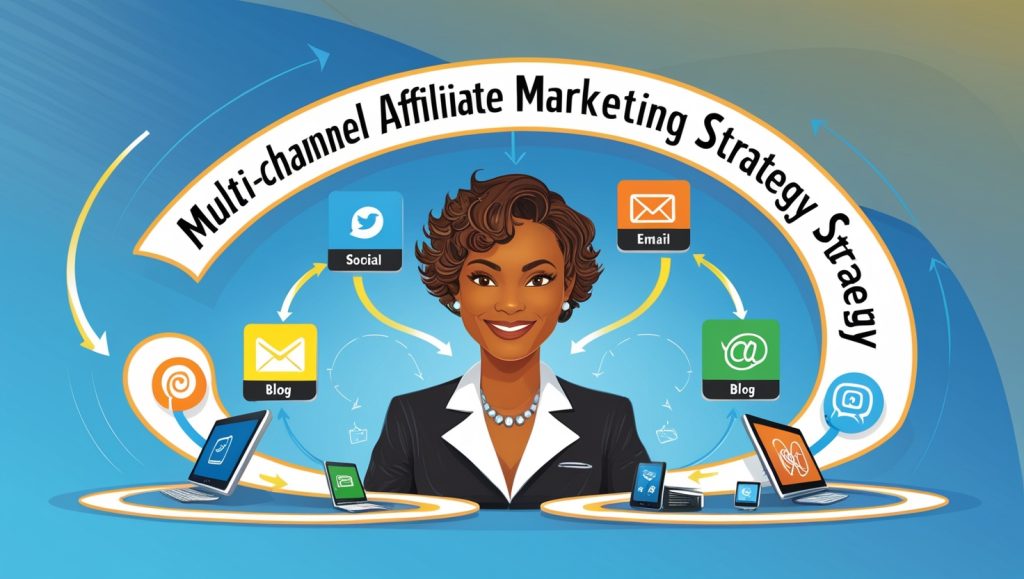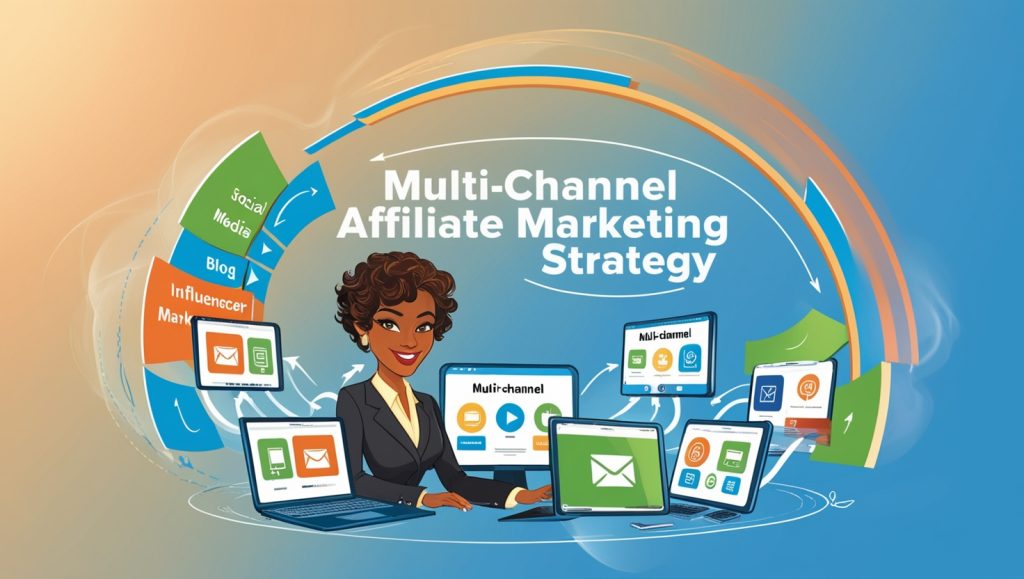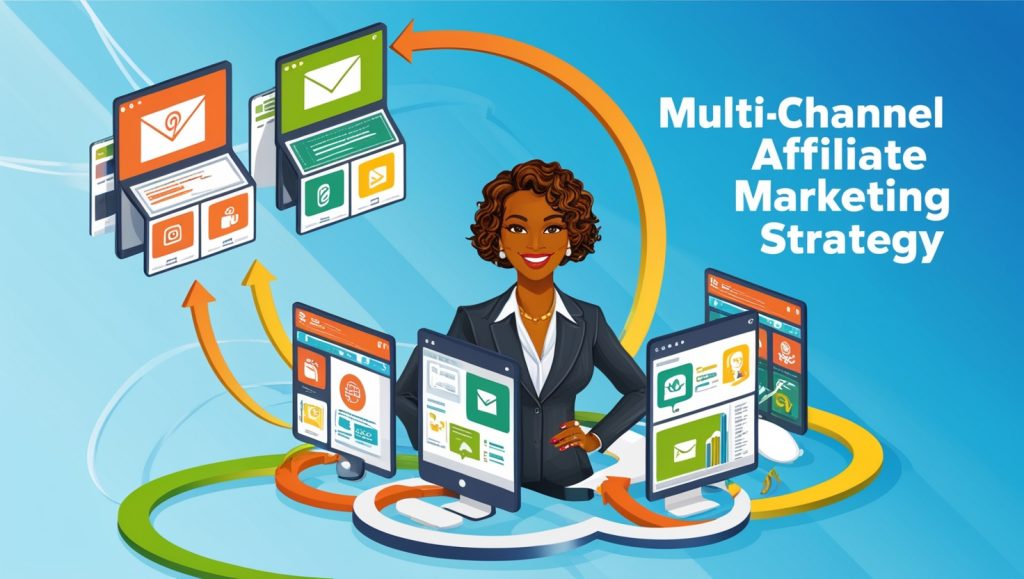

Introduction
Affiliate marketing has become a powerful tool for businesses to increase their reach, drive sales, and enhance brand visibility. By partnering with affiliates who promote their products or services, companies can tap into new audiences and benefit from a performance-based model. In today’s digital age, relying on a single channel is not enough. A multi-channel affiliate marketing strategy allows businesses to maximize their impact by leveraging various platforms and tactics. This article will guide you through the process of creating an effective multi-channel affiliate marketing strategy.
Understanding the Basics of Affiliate Marketing
How Affiliate Marketing Works
Affiliate marketing is a performance-based marketing model where affiliates earn a commission for driving traffic, leads, or sales to a merchant’s website. The process involves three main steps: finding affiliates, promoting products, and earning commissions. Affiliates use their platforms, such as blogs, social media, or email lists, to promote the merchant’s offerings. When a consumer makes a purchase or completes a desired action through the affiliate’s link, the affiliate earns a commission.
Key Players in Affiliate Marketing
Advertisers
Advertisers, also known as merchants or brands, are the companies that want to promote their products or services. They create affiliate programs and provide marketing materials for affiliates to use.
Affiliates
Affiliates are individuals or entities that promote the advertiser’s products or services in exchange for a commission. They can be bloggers, influencers, content creators, or website owners.
Consumers
Consumers are the end-users who purchase products or services through the affiliate’s promotion. Their actions trigger the commission payment to the affiliate.
Affiliate Networks
Affiliate networks act as intermediaries between advertisers and affiliates. They provide a platform for managing affiliate programs, tracking performance, and processing payments.
Benefits of a Multi-Channel Affiliate Marketing Strategy
Increased Reach and Visibility
Utilizing multiple channels allows you to reach a broader audience. Different consumers prefer different platforms, so having a presence across various channels ensures that you can connect with a diverse range of potential customers.
Diversified Risk
Relying on a single channel can be risky. If that channel experiences a decline in traffic or changes its algorithms, your entire affiliate strategy could suffer. A multi-channel approach spreads the risk and ensures stability.
Enhanced Consumer Engagement
Each channel offers unique ways to engage with consumers. For example, social media allows for real-time interaction, while email marketing provides personalized communication. Using multiple channels enhances overall consumer engagement and experience.
Better Analytics and Insights
With a multi-channel strategy, you can gather data from various sources and gain a comprehensive understanding of your marketing performance. This data can help you optimize your strategy and make informed decisions.
Identifying and Selecting the Right Channels
Social Media Platforms
Facebook is a versatile platform that supports various types of content, including text, images, videos, and live streams. It’s ideal for targeting a wide audience and running targeted ad campaigns.
Instagram is perfect for visual content and influencer partnerships. Its features like Stories and Reels offer creative ways to promote products and engage with followers.
YouTube
YouTube is the go-to platform for video content. It’s excellent for product reviews, tutorials, and unboxing videos, which can drive significant traffic and conversions.
TikTok
TikTok is a rapidly growing platform with a younger demographic. Its short-form video content can go viral quickly, making it a powerful tool for brand exposure.
Email Marketing
Email marketing remains one of the most effective channels for affiliate marketing. It allows for personalized communication and direct promotion to a targeted audience. Building a strong email list is crucial for success.
Content Marketing
Blogs
Blogs are a staple in affiliate marketing. They provide valuable content, such as reviews, how-to guides, and comparison articles, which can attract organic traffic and convert readers into customers.
Podcasts
Podcasts are gaining popularity as a medium for affiliate marketing. They offer a personal touch and can reach a dedicated audience. Mentioning products or services during episodes can drive traffic and sales.
Influencer Partnerships
Partnering with influencers can amplify your reach and credibility. Influencers have established trust with their followers, making their recommendations highly effective. Collaborating with influencers across different platforms can significantly boost your affiliate marketing efforts.
Paid Advertising
Google Ads
Google Ads allow you to target specific keywords and appear at the top of search results. This can drive highly targeted traffic to your affiliate offers.
Social Media Ads
Running ads on social media platforms like Facebook, Instagram, and LinkedIn can increase visibility and drive traffic. Social media ads offer advanced targeting options to reach your ideal audience.
Creating and Implementing Your Strategy
Setting Clear Goals and Objectives
Before diving into your multi-channel strategy, it’s essential to set clear goals and objectives. Determine what you want to achieve, whether it’s increasing sales, driving traffic, or building brand awareness. Setting specific, measurable, achievable, relevant, and time-bound (SMART) goals will help guide your strategy and measure success.
Researching and Selecting Affiliates
Identify affiliates who align with your brand and have an engaged audience. Look for affiliates with a strong online presence and a track record of promoting products effectively. Building relationships with the right affiliates is crucial for the success of your strategy.
Creating Compelling Content
Content is king in affiliate marketing. Create high-quality, engaging content that resonates with your audience. Tailor your content to each channel’s strengths. For example, use visually appealing images and videos for Instagram, in-depth articles for blogs, and interactive posts for Facebook.
Utilizing Tracking and Analytics Tools
Implement tracking and analytics tools to monitor the performance of your multi-channel strategy. Tools like Google Analytics, affiliate network dashboards, and social media insights provide valuable data on traffic, conversions, and engagement. Use this data to optimize your strategy and make data-driven decisions.
Continuously Optimizing Your Strategy
Affiliate marketing is an ongoing process. Continuously analyze your performance, test new approaches, and refine your strategy. Stay updated with industry trends and adapt to changes in algorithms and consumer behavior. Regularly communicate with your affiliates and provide them with the resources they need to succeed.
Ensuring Compliance and Transparency
Ensure that your affiliate marketing practices comply with legal and ethical standards. Disclose affiliate relationships to your audience transparently. This builds trust and credibility with your audience and helps avoid potential legal issues.
Leveraging Emerging Technologies in Affiliate Marketing

Artificial Intelligence and Machine Learning
AI and machine learning can significantly enhance your affiliate marketing strategy. These technologies can analyze vast amounts of data to identify patterns, predict outcomes, and optimize marketing efforts. For instance, AI can help identify high-performing affiliates, predict consumer behavior, and automate personalized marketing campaigns. Machine learning algorithms can also optimize your ad spend by adjusting bids in real-time based on performance data.
Blockchain for Transparency
Blockchain technology can enhance transparency and trust in affiliate marketing. It ensures that all transactions are recorded on an immutable ledger, reducing the risk of fraud. Blockchain can also provide clear attribution of sales and commissions, ensuring that affiliates are fairly compensated for their efforts. As this technology evolves, it may become a valuable tool for improving the integrity of affiliate marketing programs.
Chatbots for Customer Engagement
Integrating chatbots into your affiliate marketing strategy can improve customer engagement and support. Chatbots can provide instant responses to customer queries, guide users through the purchasing process, and recommend products based on user preferences. This can enhance the customer experience and increase the likelihood of conversions.
Voice Search Optimization
With the growing popularity of voice-activated devices like Amazon Echo and Google Home, optimizing for voice search is becoming crucial. Use natural language and long-tail keywords in your content to align with how people speak. Ensure your website is voice-search friendly by providing concise, direct answers to common questions.
Augmented Reality (AR) and Virtual Reality (VR)
AR and VR technologies can create immersive shopping experiences that enhance customer engagement. For example, AR can allow customers to visualize products in their space before making a purchase. VR can provide virtual tours or interactive experiences that showcase your products. Incorporating these technologies can set your brand apart and drive higher engagement and conversions.
Enhancing Affiliate Relationships Through Communication and Support
Regular Updates and Newsletters
Keep your affiliates informed with regular updates and newsletters. Share information about new products, promotions, and marketing tips. Consistent communication helps maintain engagement and motivation.
Dedicated Affiliate Managers
Consider appointing dedicated affiliate managers to provide personalized support. They can assist with onboarding, answer queries, and offer tailored advice to help affiliates succeed.
Creating an Affiliate Portal
An affiliate portal serves as a central hub where affiliates can access resources, track their performance, and communicate with your team. Features of an effective portal include:
- Resource Library: Provide marketing materials, product information, and promotional guidelines.
- Performance Dashboard: Allow affiliates to monitor their clicks, sales, and commissions.
- Support Center: Include FAQs, contact information, and a ticketing system for support requests.
Hosting Affiliate Webinars and Training Sessions
Webinars and training sessions can enhance affiliate knowledge and skills. Topics might include effective marketing techniques, product demonstrations, and updates on industry trends. Interactive sessions also allow affiliates to ask questions and share feedback.
Encouraging Affiliate Feedback
Solicit feedback from your affiliates regularly. This can help identify areas for improvement in your program and foster a collaborative environment. Use surveys, polls, and one-on-one meetings to gather insights.
Leveraging Data Analytics for Continuous Improvement
Performance Metrics to Monitor
Track key performance metrics to gauge the success of your affiliate marketing strategy. Important metrics include:
- Conversion Rate: The percentage of visitors who complete a desired action, such as making a purchase.
- Click-Through Rate (CTR): The ratio of users who click on an affiliate link to the total number of users who view the link.
- Average Order Value (AOV): The average amount spent by customers per order.
- Return on Investment (ROI): The financial return from your affiliate marketing efforts compared to the costs involved.
Using Analytics Tools
Utilize analytics tools to gain insights into your affiliate marketing performance. Tools such as Google Analytics, SEMrush, and Ahrefs can provide valuable data on traffic sources, user behavior, and keyword performance.
Data-Driven Decision Making
Make data-driven decisions by analyzing performance data regularly. Identify top-performing affiliates, successful campaigns, and areas for improvement. Use these insights to refine your strategy, allocate resources effectively, and enhance your overall program.
Conducting A/B Testing
A/B testing involves comparing two versions of a marketing element to determine which performs better. Test various components such as headlines, images, and calls to action to optimize your affiliate marketing efforts. Continuously test and refine your approach based on the results.
Advanced Content Strategies for Affiliate Marketing
User-Generated Content Campaigns
Encourage your customers and affiliates to create and share content about your products. User-generated content (UGC) adds authenticity and social proof, making it more persuasive than branded content. Feature UGC on your website, social media, and marketing materials to build trust and credibility with your audience.
Interactive Content
Interactive content like quizzes, polls, and interactive infographics can engage your audience and provide valuable insights. For example, a quiz that recommends products based on user responses can drive higher engagement and conversions. Interactive content also encourages social sharing, expanding your reach.
Webinars and Live Events
Hosting webinars and live events can position your brand as an industry leader and provide valuable content to your audience. Use these platforms to showcase your products, share industry insights, and answer questions in real-time. Collaborate with affiliates to co-host events, increasing your reach and providing mutual benefits.
Long-Form Content and Ebooks
Long-form content like in-depth articles, guides, and ebooks can attract organic traffic and establish your brand as an authority in your industry. Provide comprehensive information that addresses your audience’s pain points and offers solutions. Include affiliate links within this content to drive conversions.
Video Marketing
Video content is highly engaging and can effectively convey your brand message. Create product demos, tutorials, reviews, and behind-the-scenes videos. Collaborate with video influencers and affiliates to reach a broader audience. Optimize your videos for SEO by including relevant keywords, tags, and descriptions.
Optimizing Multi-Channel Campaigns
Cross-Promotional Strategies
Use cross-promotional strategies to enhance your multi-channel campaigns. For instance, promote your blog content through email newsletters and social media posts. Use social media ads to drive traffic to your YouTube videos or webinars. Cross-promotion ensures consistent messaging and maximizes your reach.
A/B Testing and Experimentation
Regularly conduct A/B testing to identify the most effective strategies and optimize your campaigns. Test different elements such as headlines, images, calls to action, and promotional offers. Use the insights gained from testing to refine your approach and improve performance across channels.
Data-Driven Decision Making
Leverage data analytics to make informed decisions about your affiliate marketing strategy. Analyze performance metrics across channels to identify trends and areas for improvement. Use tools like Google Analytics, social media insights, and affiliate network dashboards to gather data and derive actionable insights.
Personalization and Segmentation
Personalize your marketing efforts by segmenting your audience based on demographics, behavior, and preferences. Tailor your messages and offers to each segment to increase relevance and engagement. Use dynamic content and personalized recommendations to create a customized experience for each user.
Integrating CRM with Affiliate Marketing
Integrate your Customer Relationship Management (CRM) system with your affiliate marketing platform to streamline operations and enhance customer insights. A CRM can help you manage relationships, track interactions, and segment your audience. This integration provides a comprehensive view of your customers and affiliates, enabling more effective marketing strategies.
Advanced Affiliate Management Techniques

Performance-Based Incentives
Offer performance-based incentives to motivate your affiliates. For example, provide bonuses for reaching specific sales targets, generating high-quality leads, or driving traffic to new product launches. Performance-based incentives encourage affiliates to strive for better results.
Regular Performance Reviews
Conduct regular performance reviews with your affiliates to provide feedback and identify opportunities for improvement. Use performance data to discuss strengths and areas for growth. Collaborative reviews can help affiliates optimize their strategies and align with your business goals.
Affiliate Loyalty Programs
Implement loyalty programs to reward long-term affiliates and encourage continued collaboration. Offer tiered rewards based on tenure, performance, and engagement. Loyalty programs foster a sense of belonging and motivate affiliates to maintain a long-term partnership with your brand.
Transparent Communication Channels
Maintain transparent and open communication channels with your affiliates. Use platforms like Slack, Discord, or dedicated forums to facilitate real-time communication and collaboration. Transparency builds trust and ensures that affiliates are well-informed and aligned with your objectives.
Advanced Fraud Detection
Invest in advanced fraud detection tools to protect your affiliate program from fraudulent activity. Use machine learning algorithms to detect unusual patterns and flag suspicious behavior. Regular audits and manual reviews can further enhance your fraud prevention efforts.
Case Studies and Examples
Successful Case Study: Shopify’s Affiliate Program
Shopify’s affiliate program is renowned for its success. They leverage multiple channels, including blogs, social media, and email marketing. Shopify provides affiliates with extensive resources, including tutorials, webinars, and dedicated support. By focusing on education and community-building, Shopify has created a thriving affiliate network that drives substantial traffic and sales.
Best Practices from Leading Brands
- Amazon Associates: Amazon focuses on providing affiliates with a vast array of products to promote, ensuring high conversion rates. They also offer a reliable tracking and payment system.
- Bluehost: Bluehost’s affiliate program excels by offering high commissions and detailed performance analytics. They provide affiliates with comprehensive marketing materials and personalized support.
Future-Proofing Your Affiliate Marketing Strategy
Staying Updated with Industry Trends
The digital marketing landscape is constantly evolving. Stay informed about the latest trends, technologies, and best practices by following industry blogs, attending conferences, and networking with other professionals.
Investing in Continuous Learning
Encourage continuous learning for yourself and your affiliates. Provide access to educational resources, training programs, and industry certifications. Staying knowledgeable about the latest strategies and tools can give you a competitive edge.
Adapting to Technological Advances
Embrace new technologies that can enhance your affiliate marketing efforts. This might include AI for predictive analytics, blockchain for transparent transactions, and AR/VR for immersive marketing experiences. Stay open to innovation and be willing to experiment with new approaches.
Additional FAQs
1. How can I balance organic and paid strategies in my affiliate marketing?
Balancing organic and paid strategies involves allocating resources effectively to both approaches. Use organic methods like SEO and content marketing to build a sustainable foundation, while leveraging paid campaigns to drive immediate results. Regularly analyze performance to adjust your budget and efforts accordingly.
2. What are some effective ways to incentivize affiliates?
Effective incentives include offering higher commission rates for top performers, providing exclusive promotions, running contests with attractive prizes, and recognizing affiliates publicly for their achievements. Personalized incentives based on affiliate preferences can also be highly motivating.
3. How do I track the performance of my multi-channel affiliate marketing strategy?
Use tracking and analytics tools like Google Analytics, affiliate network dashboards, and social media insights to monitor traffic, conversions, and engagement across different channels. Regularly review performance metrics and adjust your strategy based on data-driven insights.
4. How can I prevent and manage affiliate fraud?
Prevent and manage affiliate fraud by implementing robust tracking and monitoring systems, using advanced fraud detection tools, conducting regular audits, and setting clear guidelines for affiliates. Swiftly address any suspicious activity and maintain transparent communication with your affiliates.
5. How can small businesses benefit from a multi-channel affiliate marketing strategy?
Small businesses can benefit from a multi-channel affiliate marketing strategy by reaching a broader audience, diversifying their marketing efforts, and leveraging the strengths of different channels. Start with a few key channels and gradually expand as you gain more experience and resources.
6. What role does content quality play in affiliate marketing success?
Content quality is crucial for affiliate marketing success. High-quality, engaging, and valuable content attracts and retains audiences, builds trust, and drives conversions. Invest in creating top-notch content tailored to your audience’s needs and preferences.
7. How can I ensure compliance with international regulations in affiliate marketing?
Stay informed about international regulations and ensure that your affiliates comply with them. Provide clear guidelines and resources to help affiliates understand legal requirements. Regular audits and monitoring can help maintain compliance.
8. How do I handle disputes or issues with affiliates?
Handle disputes or issues with affiliates professionally and promptly. Establish clear communication channels and guidelines for resolving conflicts. Address concerns fairly and transparently, and seek to find mutually beneficial solutions. Maintaining positive relationships with affiliates is crucial for long-term success.
9. How can I effectively use email marketing in my affiliate strategy?
Use email marketing to nurture leads and drive conversions by sending targeted and personalized campaigns. Segment your email list based on user behavior and preferences, and provide valuable content alongside promotional offers. Track performance metrics to optimize your email campaigns.
10. How do I measure the ROI of my multi-channel affiliate marketing strategy?
To measure the ROI, calculate the total revenue generated from your affiliate marketing efforts and compare it to the total costs incurred, including commissions paid to affiliates, advertising expenses, and any other associated costs. Use tools like Google Analytics and affiliate network dashboards to track conversions and revenue.
11. What are the best practices for selecting high-quality affiliates?
Select high-quality affiliates by evaluating their audience demographics, engagement rates, and content quality. Look for affiliates who align with your brand values and have a proven track record of driving conversions. Building strong relationships with these affiliates can enhance your program’s success.
12. How do I ensure my content stands out in a crowded market?
To make your content stand out, focus on providing value to your audience. Create high-quality, informative, and engaging content that addresses their needs and interests. Use eye-catching visuals, compelling headlines, and incorporate storytelling to capture their attention. Regularly update your content to keep it relevant and fresh.
13. How can I handle underperforming affiliates?
Address underperforming affiliates by providing additional support, training, and resources. Identify any challenges they may be facing and offer solutions. If performance does not improve, consider adjusting commission rates or ending the partnership.
14. Can affiliate marketing be integrated with other digital marketing strategies?
Yes, affiliate marketing can be integrated with other digital marketing strategies such as SEO, email marketing, and social media marketing. Combining these strategies can create a cohesive and comprehensive marketing approach that maximizes your reach and impact.
15. What are the key elements of a successful affiliate marketing landing page?
A successful affiliate marketing landing page should include a clear and compelling headline, engaging visuals, concise and persuasive copy, a strong call to action, and social proof such as testimonials or reviews. Ensure the page is optimized for SEO and mobile-friendly to enhance user experience and drive conversions.
16. How can I effectively use influencers in my affiliate marketing strategy?
To effectively use influencers, identify those who align with your brand and have an engaged audience. Collaborate on content that resonates with their followers, such as reviews, tutorials, and giveaways. Track the performance of influencer campaigns to optimize future collaborations.
17. What are the benefits of using video content in affiliate marketing?
Video content is highly engaging and can effectively showcase your products. It can increase conversion rates by providing visual demonstrations, building trust, and offering valuable information. Videos are also highly shareable, expanding your reach.
18. How do I ensure compliance with FTC guidelines in affiliate marketing?
Ensure compliance by educating your affiliates on FTC guidelines, which require clear disclosure of affiliate relationships. Use explicit language such as “affiliate link” or “sponsored post” and ensure disclosures are prominent and easily noticeable in all promotional content.
19. What role does mobile optimization play in affiliate marketing success?
Mobile optimization is crucial as a significant portion of online traffic comes from mobile devices. Ensure your website, landing pages, and promotional content are mobile-friendly to provide a seamless user experience and maximize conversions from mobile users.
20. How can I utilize user-generated content (UGC) in my affiliate marketing strategy?
Encourage customers to share their experiences and content related to your products. Feature UGC on your website, social media, and in marketing materials to build trust and authenticity. UGC adds social proof and can influence potential buyers.
21. How do I measure the effectiveness of different affiliate channels?
Use tracking and analytics tools to measure the performance of each channel. Compare metrics such as traffic, conversion rates, and ROI across different channels to identify the most effective ones. Allocate resources accordingly to maximize overall performance.
22. What are some common mistakes to avoid in affiliate marketing?
Common mistakes include not disclosing affiliate relationships, choosing the wrong affiliates, neglecting to track performance, relying too heavily on a single channel, and failing to provide adequate support to affiliates. Avoiding these mistakes can improve the effectiveness of your strategy.
23. How can I build long-term relationships with affiliates?
Build long-term relationships by offering competitive commissions, providing regular updates and resources, recognizing and rewarding top performers, maintaining open communication, and creating a sense of community. Strong relationships foster loyalty and sustained performance.
24. How do I handle rapid growth in my affiliate program?
Handle rapid growth by scaling your infrastructure, such as upgrading tracking tools and support systems. Hire additional affiliate managers to maintain personalized support. Regularly review and optimize your program to manage increased activity effectively.
25. How can I use analytics to improve my affiliate marketing strategy?
Use analytics to gain insights into affiliate performance, traffic sources, and user behavior. Identify top-performing affiliates and channels, analyze conversion data, and test different approaches. Data-driven decisions can significantly enhance your strategy’s effectiveness.
26. How can I ensure my affiliate program aligns with my overall marketing goals?
Align your affiliate program with your overall marketing goals by setting clear objectives, such as increasing sales, traffic, or brand awareness. Regularly review and adjust your affiliate strategy to ensure it supports these broader goals and integrates with other marketing efforts.
27. How can I utilize retargeting in my affiliate marketing strategy?
Use retargeting to show ads to users who have previously visited your site but did not convert. Retargeting can remind potential customers about your products, leading to higher conversion rates. Collaborate with affiliates to include retargeting in their promotional efforts.
28. What are the best practices for international affiliate marketing?
For international affiliate marketing, localize your content and marketing messages to resonate with different cultures. Understand and comply with local regulations, provide multilingual support, and use geo-targeted campaigns to effectively reach international audiences.
29. How can I leverage artificial intelligence in my affiliate marketing strategy?
Leverage AI to analyze data, predict trends, and personalize marketing efforts. Use AI-driven tools for optimizing ad spend, automating customer interactions, and identifying high-performing affiliates. AI can enhance efficiency and effectiveness in your affiliate marketing strategy.
30. What are the advantages of using a multi-channel approach in affiliate marketing?
A multi-channel approach diversifies your traffic sources, reduces reliance on a single channel, and increases reach. It allows you to engage with a broader audience, gather more comprehensive data, and adapt to changes in individual channel performance, leading to more stable and sustainable growth.
Enhancing User Experience and Conversions
Optimizing Landing Pages
Landing pages are crucial for conversions. Ensure they are:
- Clear and Concise: Use simple language and focus on the key message.
- Visually Appealing: Include high-quality images and videos that are relevant to your product.
- User-Friendly: Ensure the page loads quickly and is easy to navigate.
- SEO-Optimized: Use relevant keywords to improve search engine ranking.
- Mobile-Optimized: Ensure the page looks good and functions well on mobile devices.
Implementing Strong Calls to Action (CTAs)
A strong CTA can significantly increase conversion rates. Make sure your CTAs are:
- Action-Oriented: Use action verbs like “Buy Now,” “Sign Up,” or “Learn More.”
- Visible: Place them where they are easily noticeable.
- Compelling: Highlight the benefits of taking action.
- Urgent: Create a sense of urgency with phrases like “Limited Time Offer” or “Act Now.”
Personalizing User Experience
Personalization can improve user experience and increase conversions. Use data to:
- Recommend Products: Suggest products based on user behavior and preferences.
- Customize Content: Tailor content to different segments of your audience.
- Send Personalized Emails: Use the recipient’s name and offer relevant promotions.
Providing Social Proof
Social proof, such as customer reviews, testimonials, and case studies, can build trust and encourage conversions. Ensure social proof is:
- Authentic: Use genuine reviews and testimonials.
- Visible: Place them prominently on your website and landing pages.
- Relevant: Ensure they relate to the product or service being promoted.
Advanced Traffic Generation Strategies
Leveraging Paid Traffic
Paid traffic can provide immediate results and complement your organic efforts. Consider using:
- Google Ads: Target specific keywords to appear in search results.
- Social Media Ads: Use platforms like Facebook, Instagram, and LinkedIn to target specific demographics.
- Display Ads: Place banner ads on relevant websites to increase visibility.
Utilizing SEO Techniques
SEO is crucial for driving organic traffic. Focus on:
- Keyword Research: Identify relevant keywords and incorporate them into your content.
- On-Page SEO: Optimize title tags, meta descriptions, headers, and content.
- Backlinks: Build high-quality backlinks to improve your site’s authority.
- Technical SEO: Ensure your site is mobile-friendly, fast, and easy to navigate.
Engaging in Content Marketing
Content marketing can attract and engage your audience. Use:
- Blog Posts: Create informative and engaging articles related to your niche.
- Infographics: Visual content can be highly shareable and informative.
- Videos: Produce videos that explain, entertain, or educate your audience.
- Ebooks and Whitepapers: Offer in-depth resources that provide significant value.
Participating in Industry Forums and Groups
Industry forums and social media groups can help you connect with your audience. Engage by:
- Providing Value: Share your knowledge and help solve problems.
- Networking: Build relationships with other industry professionals.
- Promoting Content: Share your content when relevant and appropriate.
Collaborating with Other Brands
Collaborating with other brands can expand your reach. Consider:
- Co-Hosting Webinars: Partner with complementary brands to offer valuable content.
- Guest Blogging: Write guest posts for reputable blogs in your industry.
- Joint Promotions: Run joint promotions or giveaways to attract a larger audience.
Improving Affiliate Engagement and Retention
Offering Competitive Commissions
Competitive commissions can attract and retain top affiliates. Ensure your commissions:
- Are Competitive: Research industry standards and offer attractive rates.
- Include Bonuses: Provide bonuses for top performers and special achievements.
- Are Transparent: Clearly communicate how commissions are calculated and paid.
Providing Regular Updates and Resources
Keep your affiliates informed and equipped with:
- Newsletters: Regular updates about new products, promotions, and performance tips.
- Marketing Materials: High-quality banners, links, and content templates.
- Training Resources: Webinars, tutorials, and guides to help affiliates succeed.
Recognizing and Rewarding Top Performers
Recognizing and rewarding top performers can boost motivation. Consider:
- Public Recognition: Highlight top affiliates in newsletters or on your website.
- Special Rewards: Offer exclusive bonuses, higher commission rates, or gifts.
- Performance Contests: Run contests with attractive prizes for top performers.
Building a Community
Building a sense of community among your affiliates can foster loyalty and collaboration. Foster community by:
- Creating Forums or Groups: Use platforms like Facebook Groups or Slack to facilitate interaction.
- Encouraging Collaboration: Promote knowledge sharing and collaboration among affiliates.
- Hosting Events: Organize meetups, webinars, or virtual events to connect with affiliates.
Addressing Common Challenges in Affiliate Marketing

Managing Channel Conflicts
Channel conflicts can occur when multiple affiliates promote the same product. Manage conflicts by:
- Setting Clear Guidelines: Define rules for promoting products and handling conflicts.
- Using Attribution Models: Implement attribution models to fairly distribute commissions.
- Communicating Transparently: Ensure open and transparent communication with affiliates.
Ensuring Consistent Messaging
Consistent messaging is crucial for brand integrity. Ensure consistency by:
- Providing Guidelines: Offer clear guidelines on brand voice, style, and messaging.
- Reviewing Content: Regularly review affiliate content to ensure it aligns with your brand.
- Offering Templates: Provide content templates to ensure uniformity across channels.
Handling Fraudulent Activity
Affiliate fraud can undermine your efforts. Prevent and manage fraud by:
- Using Fraud Detection Tools: Implement tools that detect and prevent fraudulent activity.
- Conducting Regular Audits: Regularly review affiliate activity for suspicious behavior.
- Setting Clear Policies: Define policies and consequences for fraudulent behavior.
Adapting to Technological Changes
Stay ahead of technological changes by:
- Investing in Training: Keep yourself and your team updated with the latest trends and technologies.
- Embracing Innovation: Be open to adopting new tools and platforms that can enhance your strategy.
- Regularly Updating Tools: Ensure your tools and platforms are up-to-date and effective.
Case Studies of Successful Multi-Channel Affiliate Marketing Campaigns
Amazon Associates Program
Amazon’s affiliate program, Amazon Associates, is one of the most successful multi-channel affiliate marketing campaigns. By leveraging a wide array of channels including blogs, YouTube, social media, and email marketing, Amazon has created an extensive network of affiliates who promote their products. Amazon provides detailed tracking, regular payments, and a vast array of promotional tools, making it attractive for affiliates. The multi-channel approach has allowed Amazon to reach diverse audiences globally, resulting in increased sales and brand awareness.
Shopify’s Affiliate Program
Shopify’s affiliate program is renowned for its success. They leverage multiple channels, including blogs, social media, and email marketing. Shopify provides affiliates with extensive resources, including tutorials, webinars, and dedicated support. By focusing on education and community-building, Shopify has created a thriving affiliate network that drives substantial traffic and sales.
Bluehost
Bluehost, a popular web hosting provider, has built a successful affiliate marketing strategy by partnering with bloggers, influencers, and content creators. They provide extensive resources to their affiliates, including banners, text links, and comprehensive guides. Bluehost’s affiliates use blogs, YouTube, podcasts, and social media to promote their services. The company’s focus on high-quality content and personalized affiliate support has helped them build a strong affiliate network that drives significant traffic and conversions.
Sephora
Sephora’s affiliate marketing program effectively uses multiple channels to promote its beauty products. Affiliates include beauty bloggers, YouTubers, and Instagram influencers who create tutorials, reviews, and beauty tips. Sephora provides affiliates with exclusive promotions, early access to new products, and high-quality marketing materials. By leveraging the visual nature of platforms like Instagram and YouTube, Sephora engages its audience effectively and drives high conversion rates.
Future-Proofing Your Affiliate Marketing Strategy
Staying Updated with Industry Trends
The digital marketing landscape is constantly evolving. Stay informed about the latest trends, technologies, and best practices by following industry blogs, attending conferences, and networking with other professionals.
Investing in Continuous Learning
Encourage continuous learning for yourself and your affiliates. Provide access to educational resources, training programs, and industry certifications. Staying knowledgeable about the latest strategies and tools can give you a competitive edge.
Adapting to Technological Advances
Embrace new technologies that can enhance your affiliate marketing efforts. This might include AI for predictive analytics, blockchain for transparent transactions, and AR/VR for immersive marketing experiences. Stay open to innovation and be willing to experiment with new approaches.
Conclusion
Creating a successful multi-channel affiliate marketing strategy involves careful planning, execution, and continuous optimization. By leveraging advanced technologies, maintaining strong relationships with affiliates, and making data-driven decisions, you can build a robust and effective affiliate marketing program. Stay adaptable, transparent, and committed to providing value to your affiliates and audience. With dedication and a strategic approach, your multi-channel affiliate marketing efforts will drive significant growth, engagement, and long-term success.



